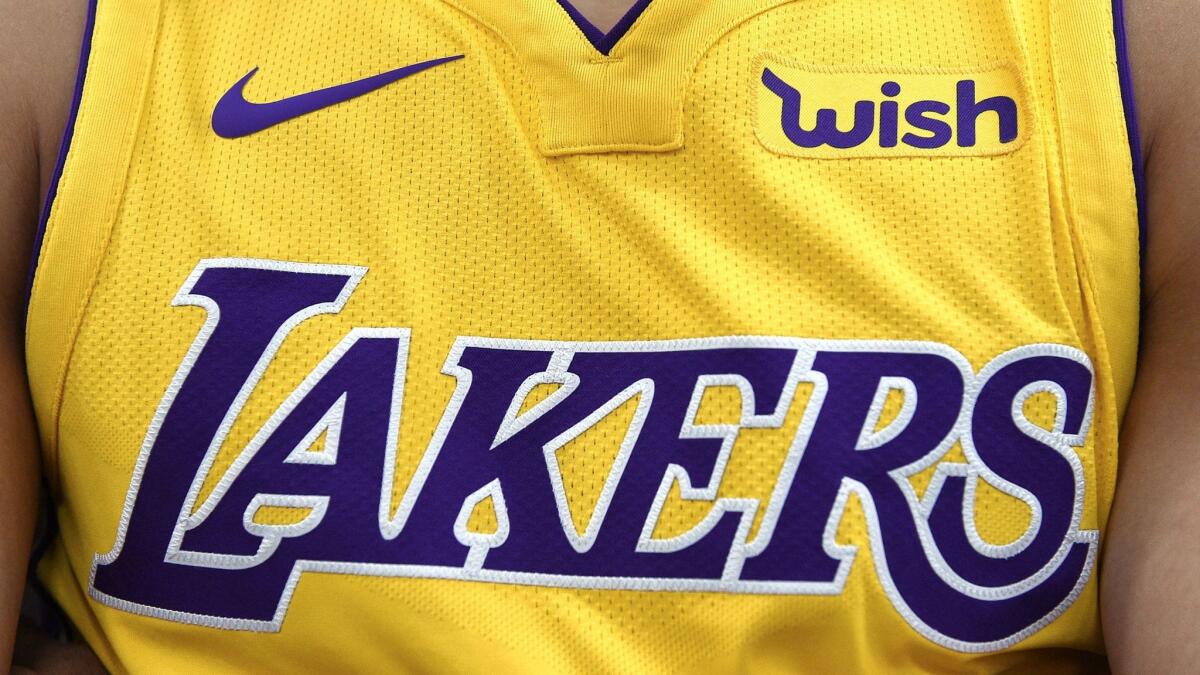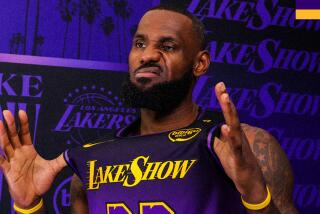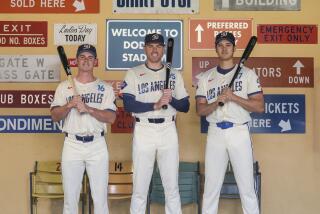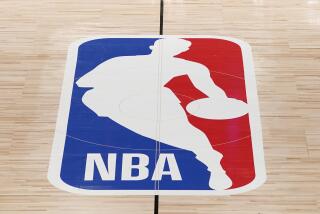Op-Ed: The NBA is turning its players into running, jumping billboards

- Share via
In the early days of professional American basketball, players ran around the court with jerseys bearing names like the Firestone Non-Skids and the General Electrics. They were glorified billboards for team sponsors. As the game grew more popular, the billboard jerseys went away. Not long after the NBA formed in 1946, team uniforms bore only numbers, cities and the team names we would come to love and hate — Lakers, Celtics, etc. A successful league was above tacky advertising.
Today, the average NBA franchise is worth $1.36 billion, and average operating profits are at a record high. No one in the league is hurting for money. But highly profitable is never profitable enough. The league has decided to take a page from its two-bit roots and put ads on its jerseys again.
For the record:
4:00 p.m. Sept. 30, 2017An earlier version of this op-ed said the Pistons’ jerseys advertise StubHub. The 76ers advertise StubHub; the Pistons, Flagstar Bank.
When the preseason opens this weekend, you’ll see corporate logos, in the form of a patch, by the left shoulders of many of your favorite players. For an estimated $5 million to $10 million in revenue per team, the NBA will break with the rest of the Big Four of American sports — Major League Baseball, the National Hockey League and the National Football League — and follow the international soccer model instead. In that sport, a lack of commercial breaks during televised games helps justify the ads; in the NBA, it’s simple greed.
The Clippers have yet to announce a sponsorship deal. The Lakers, however, are “partnering” with the e-commerce company Wish; the Celtics will wear a General Electric patch; and the 76ers, StubHub. Everyone gets a Nike swoosh too. It all looks terrible. The NBA previously denied uniform manufacturers a place to show off their logos. Now, many teams’ jerseys are practically Christmas sweaters. The workers at McDonald’s sport a cleaner look.
Ads on jerseys were never ‘inevitable.’
You’ll get used to it, people say. In 2014, NBA Commissioner Adam Silver told a sports industry conference, “As we see Champion’s League and English Premier League [soccer] televised in the U.S., I think it’s going to become more acceptable and more commonplace for our fans.” He called the ads “inevitable,” implying he was powerless to stop such an obvious moneymaker.
Sadly, sportswriters have tended to echo Silver, defending the choice as “inevitable” — which is more a dodge than a defense — and assuring us we’ll adapt. “Sure it will look strange,” offered a Bleacher Report writer, “but there isn’t any real harm here.”
In other words: “You might blanch at first, but it’ll get normalized and you’ll forget you ever had other values.”
Ads on jerseys were never “inevitable.” If they were, we’d already have seen them across American sports. Instead, while advertising has come to blanket arenas, the center of the action has remained unpolluted because even in capitalist America, there are places people don’t want ads. It’s a uniquely anti-consumerist strain of American exceptionalism that would be sad to lose.
Hokey traditions like the look of your team’s jersey are part of the fun of sports. In interviews, when athletes talk about putting on a uniform as though it’s a sacred object, it’s kind of stirring. What will be less stirring is when the soft-focus video montage accompanying a pregame interview features a Microsoft logo; it’ll just remind you your team is a corporate enterprise too.
Advertising Age suggests that the NBA was the logical league to make the ads-on-jerseys leap because its younger fans aren’t tradition-bound “purists” like followers of baseball, or even football. Poll data show that NBA fans skew progressive and they like the league’s forward-thinking stance on social justice issues. If they’re comfortable with change, the marketing logic goes, why would they object to a new look on jerseys?
Indeed, there’s a strong generation gap when it comes to approval of the ads. A 2016 YouGov poll found 49% of those under 30 thought the ads were a “good idea.” That drops to about 30% for fans from 30 to 64, and only a quarter of those 65 and older felt the same. Under-30s also were more likely to approve of the enormous existing amount of advertising in sports. These younger, progressive respondents are surprisingly the most consumerist fans.
But don’t blame the under-30s. They were raised in a world where no value outranks market value, where the pursuit of profit, and the monetization of every segment of life, simply isn’t questioned. When Ralph Nader protested the coming jersey ads in 2012 with a Change.org petition, only seven people signed.
Fans of all ages gain nothing from the new ads. The jersey patches certainly aren’t going to replace the endless commercials already dulling games. Even the players stand to gain little, spread out as the profits are in the NBA. All the good will go to the billionaire owners, all the bad to the rest of us. That 2.5-square-inch patch is a microcosm of the world today.
Fighting the profit motive is usually a losing cause. Ask the planet. Yet the only thing making this change “inevitable” is people proclaiming it so. In fact, Silver has admitted there was “enormous uncertainty” among the owners about the decision to add the patches. That uncertainty was about you. Encourage your team to stay ad-free. Mock opponents for having the patches. If your team adopts jersey ads, voice your displeasure.
The league says the shoulder patches are a three-year pilot program. That YouGov poll shows slightly more respondents disapprove than approve of the ads. If we push back, maybe, for once, a business will have to adapt to us.
Andrew Heisel has written about sports for Slate and Vice Sports. He lives in New Haven, Conn.
Twitter: @andyheisel
Follow the Opinion section on Twitter @latimesopinionand Facebook
MORE OP-EDS:
Trump’s narcissism has taken over America
Republicans and the rule of law? Save us from the sanctimony
Twitter users requested less trolling. Instead, we got tweet weight gain
More to Read
A cure for the common opinion
Get thought-provoking perspectives with our weekly newsletter.
You may occasionally receive promotional content from the Los Angeles Times.










